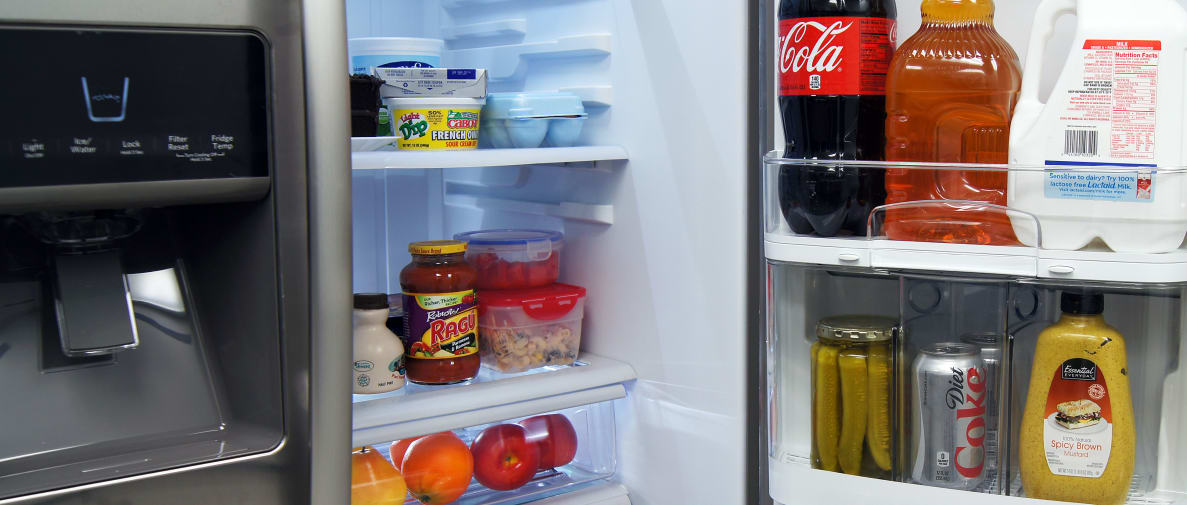Enter the KitchenAid KSF22C4CYY (MSRP $1,699). Part of the manufacturer’s upscale Architect Series II lineup, it's a side-by-side refrigerator that's just 65 7/8-inches tall—perfect for fitting under the preexisting cabinets that tend to be found in older homes. We think it's stylish, and our lab tests showed that it's a good performer, too. A through-the-door ice and water dispenser is a nice touch.
We found the KSF22C4CYY on sale for around $1,620. That's more than many top freezers, but still cheaper than most quality side-by-sides... or new cabinets. Our only major complaint is that there's no counter-depth option, with shallower variants running between 68 and 71 inches tall.
Design & Usability
Short in stature, but not on storage.
If you took a full side-by-side and squished it down by a few inches, you’d be left with a good approximation of this KitchenAid. Storage is ample, and between the glass refrigerator shelves and wire freezer shelves, there's plenty of room for customization.
The KSF22C4CYY's only significant design flaw is its narrow compartments, which lead to a particularly cramped freezer. Side-by-sides typically have trouble accommodating tall or bulky items, but this issue is even more prevalent here. However, as long as you use the height between shelves to your advantage, the problem isn't an insurmountable one.
Perhaps the most unusual design element is a tall bin built into a shelf on one of the doors. The bin flips forward for vertical access, and comes equipped with two dividing walls and a removable bucket. These features should make organization a cinch, and the bin's reasonable size means it can hold what you need without blocking the more traditional door storage.
{{ photo_gallery name="Design" }}
Performance & Features
Double check those temperatures!
Despite the presence of a touch screen, we were surprised to discover that the console used a 1-7 scale rather than actual degrees. This disappointing choice makes setting the fridge an imprecise exercise.

Despite the presence of a touch screen control panel, this fridge doesn't use a degree-based thermostat.
While the freezer’s manufacturer-recommended 4 setting proved to be more than adequate for chilling food, we noticed some disturbingly warm temperatures in the fridge. Temperatures at the top of the fridge nailed the ideal 37°F, but it got warmer the further down we went.
At crisper level, average temperatures hovered around 42°F, with peaks of almost 44°F. That's way too warm for storing anything safely. We'd recommend that you turn the temperature settings down a notch or two—and get an external thermostat to double check the end result—before putting your food away. Since temperatures didn't fluctuate too much over time in our tests, your foods should be fine as long as you make sure they're cold enough.
The KSF22C4CYY earned points for a decent crisper and low energy consumption, but we did find it to be slim on features. The icemaker and water dispenser are basically the only extras to speak of. Then again, it can be hard to find a decent side-by-side in this price range with any features at all.
{{ photo_gallery name="Icemaker" }}
For in-depth performance information, please visit the Science Page.
A Great Alternative
Upgrade your fridge, keep your cabinets
The KitchenAid KSF22C4CYY isn’t a fancy product designed to wow consumers with bells and whistles. Instead, it's a simple, well-performing machine that will fill a particular need—and a particular gap in your cabinetry.
Consumers looking to plug that top freezer-sized hole in their kitchen with something stylish and functional can turn to this machine. Folks just looking for a decent side-by-side shouldn’t rule it out, either.
With retail costs hovering around $1,620, this KitchenAid is surprisingly affordable, plus it has the added perk of through-the-door ice and water. That makes this slightly diminutive fridge a great bargain all around.
The Cold Hard Facts
The KitchenAid KSF22C4CYY (MSRP $1,699) is an affordably priced, slightly compact 22-cubic-foot side-by-side fridge. It’s also an all-around great machine that did well in most of our tests. Just make sure the fridge temperature is cold enough and all should be well.
Temperature Performance
Turn down that temp!
The main problem with this fridge's temperature controls is the fact that the fancy touch screen console uses a 1-7 temperature scale instead of actual degrees. A more distressing issue is the fridge’s recommended setting (4) was insufficient for cooling off the main compartment.

Despite the presence of a touch screen control panel, this fridge doesn't use a degree-based thermostat.
At this setting, temperatures at the top averaged a spot-on 37.36°F, but the middle and bottom clocked in at 40.12°F and 42.88°F, respectively. That’s unacceptably warm for those who don't enjoy food poisoning. Fortunately, the average fluctuation was just ±0.28°F, so turning down the fridge's temperature setting should help mitigate the issue.
On the other hand, the freezer’s default setting was downright fantastic. Average temperatures of -2.45°F at the top and -0.22°F at the bottom are more than adequate for chilling food. An average fluctuation of ±0.44°F means freezer burn shouldn’t be too much of a problem.
Moisture Retention
Standard crisping
While the KSF22C4CYY has three drawers in the fridge, only one of them has an adjustable humidity setting. Over the course of three days, the test materials we placed in the drawer with an adjustable humidity setting lost an average of 0.2 grams of moisture per hour. That’s slightly worse than average, but not by much. Keep an eye on your produce, and you should be fine.
Freezing & Thawing
Adequate freezing
The KitchenAid’s freezing performance was satisfactory, if not remarkable. Room temperature materials were chilled to 32°F in one hour and 30 minutes.
We found cold air to be suitably insulated as well. After 36 hours unplugged—simulating a power outage—internal temperatures had only warmed up to 29.84°F.
Storage Space & Energy Efficiency
Tight space, but very efficient
Since this KitchenAid is essentially a compact version of a full-size side-by-side, some of the compartments can feel a bit tight. The fresh food compartment, with its three shelves, three drawers, and customizable door storage, serves up 10.19 cubic feet of usable storage just the same.
The freezer feels a bit more cramped, with only 4.07 cubic feet available for use. Four shelves, one drawer, and four more small shelves on the door do their best to make the most of the narrow compartment. There’s also a small icemaker at the top of the freezer door.
This appliance uses an exceptionally small amount of energy, even with the icemaker running. It only needs 0.09 kWh to cool each cubic foot. At a rate of $0.09 per kWh, you’ll only need to spend about $42.27 per year to power the machine.
Meet the tester
Matthew is a native of Brockton, MA and a graduate of Northeastern, where he earned a degree in English and Theatre. He has also studied at the Gaiety School of Acting in Dublin and spends most of his free time pursuing a performance career in the greater Boston area.
Checking our work.
Our team is here to help you buy the best stuff and love what you own. Our writers, editors, and experts obsess over the products we cover to make sure you're confident and satisfied. Have a different opinion about something we recommend? Email us and we'll compare notes.
Shoot us an email


